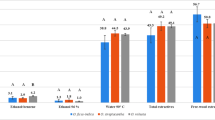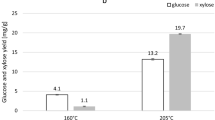Abstract
To clarify liquefaction ratios and their construction variations of the main chemical compositions of wood in phenol using phosphoric acid as a catalyst, the chemical ingredients of wood such as holocellulose, cellulose and lignin, were measured and extracted according to GB methods. With Fourier transform infrared (FTIR), the product identification of reactant before and after liquefaction in phenol was investigated. The molecular weights and their distributions of the liquefaction results (acetone soluble parts) were studied by gel permeation chromatography (GPC). Results show that the molecular weights and their distributions of poplar and Chinese fir are almost the same. In poplar, the distribution of cellulose is the largest, and that of holocellulose the smallest after liquefaction. For Chinese fir, the distribution of holocellulose is the largest, and that of cellulose the smallest. After liquefaction of poplar cellulose, the change bands of FTIR spectrum observed below 1 600 cm−1, can be attributed to new substitute groups. The same is true for poplar lignin. For Chinese fir, the spectra of liquefaction results of all chemical compositions differ from that of wood meal. This reveals the more activity groups were produced because of the reactions between Chinese fir and phenol. The research shows that the liquefaction ratios of poplar decrease in the following order: holocellulose > lignin > cellulose, and those of Chinese fir in the order: lignin > cellulose > holocellulose.
Similar content being viewed by others
References
Alma M H, Yoshioka M, Yao Y, Shiraishi N. 1996a. The preparation and flow properties of HCl catalyzed phenolated wood and its blends with commercial novolak. Holzforschung. 50: 85–90
Alma M H, Yoshioka M, Yao Y, Shiraishi N. 1996b. Preparation of sulfuric acid-catalyzed phenolated wood resin. Wood Science and Technology. 32: 297–308
Faix O. 1991. Classification of lignins from different botanical origins by FTIR spectroscopy. Holzforschung. 45(Suppl.): 21–27
He J, Wu S H. 2002. Liquefaction of wood and its applications in polymer material. China Wood Industry. 16(2): 9–11, 18
Lee S H, Ohkita T. 2003. Rapid wood liquefaction by supercritical phenol. Wood Science and Technology. 37: 29–38
Lee S H, Teramoto Y, Shiraishi N. 2002b. Acid-catalyzed liquefaction of waste paper in the presence of phenol and its application to Novolak-tape phenolic resin. J Applied Polymer Science. 83: 1 473–1 482
Lee S H, Yoshioka M, Shiraishi N. 2002a. Resol-type phenolic resin from liquefied phenolated wood and its application to phenolic foam. J Applied Polymer Science. 84: 468–472
Li G, Qin T, Ikeda A. 2003. Preparation and characterization of the phenolated wood using sulfuric acid as a catalyst II: FTIR and GPC characterization. Chinese Forestry Science and Technology. 2(2): 43–49
Lin L, Yoshioka M, Yao Y, Shiraishi N. 1995a. Physical properties of moldings from liquefied wood resins. J Applied Polymer Science. 55: 1 563–1 571
Lin L, Yoshioka M, Yao Y. 1995b. Preparation and properties of phenolated wood/phenol/formaldehyde cocondensed resin. J Applied Polymer Science. 58: 1 297–1 304
Shiraishi N. 1986. Plasticization of wood (in Japanese). Mokuai Gakkaishi. 32(10): 755–762
Yamata T, Ono H, Ohara S, Yamaguchi A. 1996. Characterization of the products resulting from direct liquefaction of cellulose I: Identification of intermediates and the relevant mechanism in direct phenol liquefaction of cellulose in the presence of water. Mokuai Gakkaishi, 42(11): 1 098–1 104
Yamata T, Ono H. 1999. Rapid liquefaction of lignocellulosic waste by using ethylene carbonate. Bioresource Technology. 70: 61–67
Yamata T. 1999. The development of liquefaction technique of wood and the identification of the relevant mechanism (in Japanese). Mokuai Gakkaishi. 54(1): 2–7
Zhang Q H, Zhao G J, Chen J P. 2004. Effects of acid catalysts on liquefaction of wood in phenol (in Chinese with English abstract). J Bei**g Forestry University. 26(5): 66–70
Zhang Q H, Zhao G J, Jie S J. 2004. Effect of phosphoric acid on liquefaction of wood in phenol and the optimum liquefaction processing parameters. Forestry Studies in China. 6(3): 50–54
Zhang Q H, Zhao G J. 2003. Liquefaction of wood by using phenol or polyhydric alcohols (in Chinese with English abstract). J Bei**g Forestry University. 25(6): 71–76
Author information
Authors and Affiliations
Corresponding author
Additional information
[Supported by the Key Research Program Foundation, Ministry of Educational of China (Grant No. 02021) and the National Natural Science Foundation of China (Grant No. 30471351)]
Rights and permissions
About this article
Cite this article
Zhang, Qh., Zhao, Gj. & Jie, Sj. Liquefaction and product identification of main chemical compositions of wood in phenol. For. Stud. China 7, 31–37 (2005). https://doi.org/10.1007/s11632-005-0018-8
Received:
Accepted:
Issue Date:
DOI: https://doi.org/10.1007/s11632-005-0018-8




